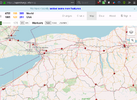The whole hotel thing is one of the rare instances of "charging anxiety" that I experience.
Over the past two summers I have visited family in western New York (southern tier) where there were no fastchargers en route and very few L2 chargers. To give you a sense, the distance from the last supercharger en route to the next one was 343 miles (there is a new one that opened up since last summer, but that only cuts it down to 309 miles). There is a Supercharger with a 30 mile deviation that I could have used as a last resort though.
In one town, I know for sure there is no L2 charging available and if I'm lucky I can plug into 120V overnight if the spot near the side door is open, but of course that doesn't do me much good other than to replenish a bit of the driving around I did while in town. In the next town, there are at least some hotels with charging stations, one of which was brand new and wasn't even on Plugshare (or ChargePoint, even though it was a ChargePoint station) yet (but was listed on the hotel's web site).
So what's my strategy? Do I charge to 100% at the first Supercharger and hope that I can get enough 120V charging to make it to the second Supercharger (or keep trying any available L2s along the route?) Just plan on the 30 mile diversion to the other Supercharger? Risk it and hope that the hotel's charging station really does exist, works, and is not in use the night I am there?
It was even worse the the year before when we took the VW ID.4 and the 30-mile off route Supercharger was not in play, although there is now a CCS fastcharger that is only about 10 miles off route.
Ideally for hotel use, it would be good to have the following:
- Positive (live) indication that a station is live. Preferably if the given network's site/app were reliable enough to be trusted, but at least show me a list of anonymized charging sessions that were logged on the charging station so I can be reasonably sure it was successfully used (I look at Plugshare too, but most of the time people don't bother to log their charges).
- The ability to reserve a station for a given part of my stay, even if I have to pay extra for the privilege (peace of mind).
- An expectation that the station will not be ICEd or otherwise blocked.
We may not need every parking spot able to charge, but at the opposite end of the spectrum, having only one or two stations at a given property is just unsettling and it does make it difficult to effectively plan a trip through areas that don't have a lot of coverage. Of course those are the same areas where property owners are likely to be behind the times and not proactively making sure that charging is available and reliable.
In the end, it worked out both years for me. The first year we stayed at a hotel with a Tesla and a J1772 charger (we used the J1772) and the hotel manager was reasonably knowledgeable about the chargers and coned it off for us (well, he tried and coned off the Tesla, but we had the VW that year...but the J1772 was open when we arrived).
The second year we stayed at the new hotel and I was quite nervous about it, but went with the "risk it" plan, knowing that worst case I could do the 30 mile diversion. But I also topped up more than I really needed to at the first Supercharger to account for the extra distance, local driving, vampire drain, etc. It sure would have been nice to just be able to count on being able to charge at the hotel.



